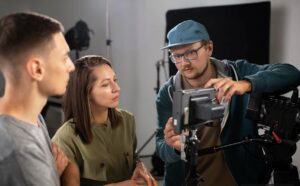This guide is designed to provide you with an overview of the Visual Arts IB Internal Assessment. This assessment is a required component of the IB Visual Arts program and allows students to demonstrate their understanding of the creative processes, research strategies, and reflective writing that is necessary to create a successful internal assessment.
You will learn about the structure and criteria for the internal assessment, tips for effective time management and research, ideas for getting started on your assignment, and resources for further reading.
By the end of this guide, you should have a better understanding of the Visual Arts IB Internal Assessment and the many components involved in creating a successful project.
Objectives of the guide:
- Introduce the post’s topic and subject.
- Provide an overview of the Visual Arts IB Internal Assessment.
- Explain how creative processes can be applied.
- Offer helpful time management tips.
- Share advice on assessing and planning.
- Outline key referencing and resource materials.
- Provide examples and ideas.
- Discuss important aspects of reflective writing.
- Summarize the key points.
- Share additional resources.
- Prompt readers for feedback.
We hope this guide will help you become more confident and comfortable with the Visual Arts IB Internal Assessment process. You’ll find valuable information here that you can use when completing your own assignment.
Overview of Visual Arts IB Internal Assessments
The International Baccalaureate Organisation (IBO) offers the world’s leading academic qualifications in more than 150 countries. Within the organisation, the Visual Arts subject area is open to students aged 16-19 and assesses skills in the creative process and reflective thinking through Internal Assessments.
The IB Visual Arts Internal Assessment will typically involve two parts: the Process Portfolio and Reflective Statement. The Process Portfolio will account for 60-70% of the total mark and assesses the student’s creative processes and techniques throughout the project. It may include sketches, photographs of the artwork, short videos, and other forms of documentation showing the progress of the work over a period of time.
The Reflective Statement will account for 30-40% of the total mark and assesses the student’s ability to reflect on their artistic practice and explain the choices made during the creative process. It should include insights, critical reflections, and reflection on works of art from other cultures or periods in the past.
Overall, the IB Visual Arts Internal Assessment should provide evidence that the student has developed knowledge in their chosen field and has used both practical skills and reflective reasoning to develop an artwork or body of work. It should show that the student can demonstrate understanding of disciplinary concepts, methods, and materials, as well as a familiarity with works of art from various cultures or periods in the past.
Exploring the Creative Process for Visual Arts IB Internal Assessments
The creative process is an essential part of the Visual Arts Internal Assessment (IA) and can be used to generate ideas and produce work. Before beginning a visual arts IA, it’s important to understand how creative processes work and how they can be applied to your project.
Creative processes involve steps that help creative people create original work. They typically involve research and planning, idea generation, exploration and experimentation, evaluation, development, and production. Each step has its own purpose and helps the artist to plan and evaluate their artwork.
Research and planning involves gathering information about the project, determining the problem or issue to be addressed, and setting goals. This step is crucial because it helps define the scope of the project and helps you plan how to approach it. Idea generation is the next step, which involves brainstorming and synthesizing ideas for the project. After the ideas have been generated and explored, it’s time to evaluate them and decide which ones are best suited for the project.
Exploration and experimentation involve experimenting with different media and techniques to test out and refine the ideas. This step allows the artist to assess what works best to convey the message of their project and get a better understanding of the materials they will use. Development is the creative process of translating ideas into tangible artwork, while production involves producing the finished artwork. This could include completing the artwork and presentation of the final product.
Each step of the creative process should be considered when working on a Visual Arts IB Internal Assessment. Taking the time to thoroughly think through each stage will ensure that the project meets the necessary requirements and reflects the artistic intentions of the student.
Research Strategies for Visual Arts Internal Assessments
Research is one of the most important aspects of completing a successful Visual Arts IB Internal Assessment. It involves gathering information, thinking critically about it, and summarizing and presenting those findings in your own words. Research involves both exploration and analysis, and the more time you spend on research, the better your end result will be.
In order to research effectively for your Visual Arts Internal Assessment, there are several key strategies that you should consider. First, think about what type of project you’re working on and identify some keywords or topics that you should research. Once you’ve done that, it’s time to start researching. You can search online, visit the library, or talk to an expert. Whatever route you choose, make sure that you have reliable sources to draw upon.
When researching, it’s important to take notes. Note down your ideas, findings, and any relevant quotes that you come across. This will help to make the writing process smoother when you come to summarising and presenting your findings in the final assessment. Make sure to aim for a good balance between primary and secondary sources.
Another important aspect of researching is being selective with your information. You don’t want to overload yourself with too much information, as this can make it difficult to extract the best insights from your research. Instead, fill your notes with only the information that is necessary for your project.
Finally, don’t forget to back up your research with data, figures, and statistics. This adds more substance to your work, and makes it clear that the conclusions you’ve drawn from your research are backed up by hard evidence.
Researching for your Visual Arts Internal Assessment doesn’t need to be complicated. By following these strategies and using the right tools, you can make sure that you have all the information you need to make your project a success.
Time Management Tips
Completing effective Visual Arts Internal Assessments (IA) by the International Baccalaureate (IB) program requires strict time management. To ensure your success, it is essential to plan, create and complete effective IAs.
The following are some useful tips for managing your time when embarking on a Visual Arts IA:
- Create a timeline with due dates – Making important notes in your calendar or diary is an effective way of managing your timeline. Staying on top of deadlines is key to success.
- Prioritise tasks – Set yourself realistic and achievable goals. Prioritising tasks will help you manage your workload and identify what needs to be done first.
- Develop a productive routine – Finding a productive and efficient routine for completing tasks will help you stay focused when it comes to the IA.
- Take regular breaks – Taking regular breaks throughout the day is important so that you can focus on the task at hand and not get overwhelmed.
- Find accountability partners – Find someone who is also working on an IA to hold each other accountable when it comes to staying on task and hitting deadlines.
- Do not procrastinate – Just get started and keep going! Even if you just do a little bit each day, it will add up over time.
These are just some of the tips for managing your time when working on a Visual Arts IA. Remember that planning ahead and staying on top of deadlines is key to success.
Strategies & Advice for IB Visual Arts Internal Assessments
Creating an effective visual arts Internal Assessment (IA) project can be daunting. However, it’s important to remember that planning and following strategies are key to success. We’re here to provide you with help and advice to get your IA off on the right foot.
Start by assessing and evaluating the works of others in the field. Take mental notes of the shapes, colors, and patterns. Pay attention to how successful artists have used elements of design to create certain effects. This will help you when it comes time to create your own artwork.
With the evaluation of other artworks, it’s good to have a plan or strategy. You’ll probably want to break down the IA project into individual sections. For example, you could consider research, evaluation, creation, and reflection. Each section should include goals and tasks so that you know what needs to be done.
It’s essential to be organized when working on an IA. Keep track of deadlines, notes, and resources. Spend some time each day analyzing, researching and creating art. This will help you stay motivated and focused on the task at hand.
Remember that experimentation is key; don’t worry if something doesn’t turn out like you originally planned. The idea is to explore, learn and experiment. Once the project is completed, self-evaluate, identify successes and areas for improvement – use this to inform future work.
Be sure to document your progress. Photographs of artwork, jot notes and keep records of where inspiration came from, such as magazine clippings or books. This will help you prepare for the reflection part of the IA.
Finally, it’s important to have a clear understanding of the criteria and requirements of the IA. Make sure you meet all of the criteria and check with your supervisor to make sure you’re on the right track. Be sure to review all of the guidelines for the project before submitting it.
Strategizing and having a plan is the best way to go about completing an IB Visual Arts internal assessment. Following these steps can help you stay organized, focused and motivated throughout the project. Good luck!
Useful Examples & Ideas
Proficiently completing your Visual Arts Internal Assessment (IA) project can be a tricky endeavour, however, with the right examples and ideas, it is definitely achievable. Here are some examples of good IA projects that you can use to inspire or guide your own:
- Creating a modern art exhibit by exploring themes such as gender and identity.
- Researching the history of mural painting and creating an installation in a public space.
- Developing a series of prints that examines the effects of technology on society.
- Exploring the intersectionality between music, video, images and text.
- Exploring the concept of using performance art to express emotion.
- Constructing a film that employs the language of poetry, to give voice to a story.
In addition to considering examples, it can also be helpful to consider different ideas and approaches to the project. For example, you may want to consider working with other mediums such as sculpture, photography, or illustration. You could also explore the presentation of your artwork, instead of just focusing on the artwork itself. Additionally, you can also think of creative ways to share your work, such as through digital portfolios, interactive websites, or even 3D printing.
IB VA IA Topics
Each topic includes three research questions (RQs) along with a brief overview outlining how students might approach their investigation—from researching context and theory to creating or analyzing artworks—in line with IB Visual Arts criteria.
1. The Use of Color in Expressing Emotion in Contemporary Art
- RQ1: How do contemporary artists use color theory to evoke specific emotions in their work?
Overview: Analyze a selection of artworks, study color palettes and corresponding psychological theories, and discuss how color influences viewer response. - RQ2: To what extent does the cultural context of an artwork affect the interpretation of its color choices?
Overview: Compare artworks from different cultural backgrounds, researching cultural symbolism and contextual influences on color meaning. - RQ3: How has the evolution of color usage in art influenced modern perceptions of emotion and mood?
Overview: Investigate historical developments in color theory and examine shifts in artistic practice, relating past innovations to contemporary trends.
2. The Role of Mixed Media in Modern Sculpture
- RQ1: How does the integration of non-traditional materials impact the conceptual depth of contemporary sculptures?
Overview: Evaluate sculptures that incorporate found objects or unconventional media, exploring how material choices enhance narrative or conceptual layers. - RQ2: To what extent do mixed media techniques challenge traditional boundaries of sculpture?
Overview: Compare classical sculpture with modern mixed media works, discussing how new materials redefine form and function. - RQ3: How can the juxtaposition of disparate materials create tension and dialogue within a single work?
Overview: Analyze case studies where contrasting materials are used intentionally to provoke discussion and evoke complex viewer interpretations.
3. The Influence of Digital Technology on Traditional Painting Techniques
- RQ1: How do contemporary painters incorporate digital tools to enhance or transform traditional painting methods?
Overview: Investigate artists who merge digital processes with hand-painted techniques, documenting the hybrid practices and resulting visual effects. - RQ2: To what extent does the use of digital media affect the tactile qualities and perceived authenticity of a painting?
Overview: Compare works created solely by traditional means with those incorporating digital elements, and assess viewer perceptions through surveys or critical reviews. - RQ3: How has digital technology expanded the conceptual boundaries of painting as an art form?
Overview: Explore the evolution of painting in the digital era, discussing how technology inspires new themes, aesthetics, and methods of production.
4. Exploring Identity through Portraiture
- RQ1: How do contemporary portrait artists represent personal and cultural identity through visual symbolism?
Overview: Analyze a series of portraits, examining symbolic elements (e.g., props, color, background) that convey complex narratives of identity. - RQ2: To what extent does self-portraiture serve as a tool for personal expression and social commentary?
Overview: Investigate self-portraits by contemporary artists, considering autobiographical elements and the broader cultural discourse they engage with. - RQ3: How does the evolution of portraiture reflect changing societal notions of individuality and community?
Overview: Trace historical and modern portrait practices, and discuss how shifts in style mirror societal changes in the understanding of identity.
5. The Evolution of Street Art and Its Social Commentary
- RQ1: How has street art evolved from a form of subversive expression to a mainstream art movement?
Overview: Research the historical context of street art, document key artists and movements, and analyze the factors contributing to its mainstream acceptance. - RQ2: To what extent does street art function as a medium for social and political critique?
Overview: Examine specific works that comment on societal issues, evaluating the impact of public art on community awareness and political discourse. - RQ3: How do location and context influence the meaning and reception of street art?
Overview: Analyze artworks in different urban settings, considering how spatial and cultural contexts alter viewer interpretation and message delivery.
6. Abstraction and Form in Minimalist Art
- RQ1: How do minimalist artists use simple forms and limited color palettes to evoke complex ideas?
Overview: Study key minimalist artworks, analyze formal elements, and discuss how simplicity can lead to deep, contemplative experiences. - RQ2: To what extent does the reduction of detail in minimalist art challenge traditional narrative expectations?
Overview: Compare minimalist works with more representational art, exploring the shift from storytelling to experiential and emotional responses. - RQ3: How has the minimalist movement influenced contemporary approaches to abstraction in art?
Overview: Investigate the legacy of minimalism and its impact on current abstract practices, highlighting similarities and departures in technique and theory.
7. The Relationship Between Art and Politics in the 21st Century
- RQ1: How do contemporary artists use visual language to comment on current political issues?
Overview: Analyze artworks addressing topics such as migration, climate change, or social justice, and discuss how artistic choices amplify political messages. - RQ2: To what extent has the democratization of art through digital media transformed political discourse?
Overview: Explore the intersection of digital art, social media, and political activism, considering how new platforms shape artistic expression and public engagement. - RQ3: How can art serve as a catalyst for social change in politically turbulent environments?
Overview: Examine case studies where art has mobilized communities, evaluating the practical and symbolic roles of art in fostering dialogue and action.
8. The Impact of Cultural Heritage on Contemporary Art Practices
- RQ1: How do contemporary artists integrate elements of their cultural heritage into modern artworks?
Overview: Analyze works that fuse traditional motifs, techniques, or materials with contemporary forms, discussing the dialogue between past and present. - RQ2: To what extent does cultural appropriation versus cultural appreciation manifest in the works of globalized artists?
Overview: Research controversies and critical debates, comparing examples where cultural elements are reinterpreted or misused. - RQ3: How does the reinterpretation of traditional art forms contribute to the evolution of a nation’s visual identity?
Overview: Investigate national art movements that incorporate heritage, and assess the impact on collective cultural narratives.
9. Representation of Gender in Visual Art
- RQ1: How do contemporary artworks challenge or reinforce traditional gender stereotypes?
Overview: Evaluate a range of works by diverse artists, analyzing how visual elements (symbolism, composition, subject matter) comment on gender roles. - RQ2: To what extent does the representation of gender in art reflect broader societal changes in gender politics?
Overview: Compare historical and modern artworks, considering shifts in representation alongside evolving cultural attitudes toward gender. - RQ3: How do self-representations by women artists contribute to the discourse on female identity and empowerment?
Overview: Examine self-portraits and autobiographical works, discussing how personal narratives reshape traditional notions of gender and identity.
10. The Use of Installation Art to Create Immersive Environments
- RQ1: How does installation art manipulate spatial perception to engage audiences?
Overview: Analyze installations that transform spaces, discussing techniques used to create immersive, multi-sensory experiences. - RQ2: To what extent do interactive elements in installations enhance audience participation and meaning-making?
Overview: Evaluate installations with interactive components, gathering audience feedback and discussing the role of engagement in art. - RQ3: How does the temporary nature of installations affect the preservation of artistic intent and viewer interpretation?
Overview: Research the ephemerality of installations, considering how time, space, and context contribute to the work’s overall impact.
11. Visual Storytelling in Graphic Novels
- RQ1: How do visual and narrative elements combine to convey complex stories in graphic novels?
Overview: Analyze selected graphic novels, exploring the interplay of sequential art, dialogue, and imagery in narrative construction. - RQ2: To what extent does the layout and panel design influence the pacing and emotional impact of a graphic narrative?
Overview: Study the design choices in graphic novels, examining how structure and visual rhythm contribute to storytelling. - RQ3: How does the use of symbolism and visual metaphors in graphic novels communicate themes and messages?
Overview: Investigate key examples where visual metaphors are central to narrative meaning, and discuss their interpretative possibilities.
12. New Media Art: The Intersection of Art and Technology
- RQ1: How do digital installations challenge traditional definitions of art?
Overview: Analyze new media artworks that incorporate digital, interactive, or virtual elements, discussing how technology expands artistic boundaries. - RQ2: To what extent does the use of augmented reality (AR) in art create new forms of audience interaction?
Overview: Evaluate AR-based artworks, document user experiences, and analyze how digital overlays transform viewer engagement. - RQ3: How has the proliferation of social media influenced the production and distribution of new media art?
Overview: Research case studies where digital platforms have enabled new artistic expressions, and discuss the implications for art markets and cultural exchange.
13. The Influence of Surrealism on Modern Visual Narratives
- RQ1: How do contemporary artists draw inspiration from Surrealist techniques to explore subconscious themes?
Overview: Examine modern works that employ dreamlike imagery and symbolism, comparing them to classical Surrealist practices. - RQ2: To what extent does the juxtaposition of unexpected elements in art create a sense of the uncanny?
Overview: Analyze specific artworks where surreal juxtapositions evoke emotional and intellectual responses, discussing theoretical frameworks. - RQ3: How does the reinterpretation of Surrealism reflect changes in societal perceptions of reality and fantasy?
Overview: Investigate shifts in Surrealist themes over time, discussing how modern contexts have transformed traditional notions of the surreal.
14. The Role of Texture and Material in Visual Expression
- RQ1: How do different textures in mixed media artworks influence viewer perceptions of depth and emotion?
Overview: Analyze works that combine various materials, focusing on how tactile qualities contribute to overall artistic impact. - RQ2: To what extent does the physicality of materials (e.g., canvas, metal, fabric) affect the interpretation of an artwork?
Overview: Compare artworks using different substrates, discussing how material properties interact with visual style and context. - RQ3: How can experimental techniques in applying materials lead to innovative visual expressions?
Overview: Explore case studies of experimental artworks, document the process of material manipulation, and analyze resulting visual narratives.
15. Exploration of Scale and Space in Public Art
- RQ1: How does scale in large-scale public art installations affect the viewer’s experience and interaction with the work?
Overview: Study monumental artworks, considering how size and placement within public spaces influence perceptions and engagement. - RQ2: To what extent does the interplay between art and architecture in urban settings create dialogue about space and community?
Overview: Analyze public artworks integrated into urban landscapes, examining how they respond to and transform their environments. - RQ3: How can scaling principles be used to adapt artworks to different public spaces without losing intended impact?
Overview: Research methods for scaling artworks, and propose strategies for maintaining visual integrity and message across diverse spatial contexts.
16. The Aesthetics of Decay: Urban Art and Ruins
- RQ1: How do artists use the aesthetics of decay to comment on urban transformation and renewal?
Overview: Examine artworks that incorporate or depict decay, discussing how deterioration can serve as a metaphor for cultural or societal change. - RQ2: To what extent does the urban environment influence the visual narratives of decay in art?
Overview: Analyze site-specific artworks and installations in urban ruins, exploring the interaction between subject matter and setting. - RQ3: How do varying representations of decay challenge traditional beauty norms in visual culture?
Overview: Compare artistic portrayals of decay with conventional aesthetic standards, discussing critical responses and evolving cultural perceptions.
17. The Concept of the Sublime in Landscape Painting
- RQ1: How do historical landscape paintings convey the sublime through composition and color?
Overview: Analyze classic landscape artworks, focusing on compositional techniques and color choices that evoke awe and grandeur. - RQ2: To what extent do modern landscape painters reinterpret the sublime in the context of urban or industrial environments?
Overview: Compare traditional depictions with contemporary interpretations that incorporate modern subjects, discussing shifts in conceptualization. - RQ3: How can the sublime be expressed through abstract or non-representational forms in landscape art?
Overview: Investigate abstract landscape works, exploring how non-literal elements create a sense of vastness and transcendence.
18. The Impact of Globalization on Contemporary Art Practices
- RQ1: How does globalization influence the themes and techniques employed by contemporary artists?
Overview: Examine artworks by artists working in a global context, discussing how cross-cultural influences shape their practices. - RQ2: To what extent does the international art market affect the production and dissemination of contemporary art?
Overview: Research case studies on art market dynamics, and analyze how global economic factors influence artistic trends. - RQ3: How do digital platforms facilitate the exchange of artistic ideas and contribute to the evolution of visual culture?
Overview: Evaluate the role of online galleries, social media, and virtual exhibitions in shaping contemporary art discourse.
19. The Role of Performance in Visual Art
- RQ1: How does the integration of performance elements transform traditional visual art practices?
Overview: Analyze works that merge performance with visual media, exploring how temporality and bodily presence contribute to meaning. - RQ2: To what extent do audience interactions influence the outcome of performance-based art installations?
Overview: Document case studies where viewer participation is integral to the work, and analyze the dynamic interplay between performer and audience. - RQ3: How can performance art challenge conventional boundaries between art forms and blur the lines between creation and experience?
Overview: Investigate artworks that integrate live performance, discussing theoretical perspectives on the role of the spectator in art.
20. The Exploration of Memory and Time in Conceptual Art
- RQ1: How do contemporary conceptual artists use visual symbols to represent memory and temporality?
Overview: Examine artworks that explore themes of memory, time, and transience, analyzing symbolic elements and narrative strategies. - RQ2: To what extent does the process of creating art function as a means of recording and reinterpreting personal or collective memory?
Overview: Research artist statements and practice, and evaluate how process documentation and iterative creation contribute to memory representation. - RQ3: How can the juxtaposition of historical and contemporary imagery in conceptual art generate new interpretations of the past?
Overview: Compare artworks that combine archival imagery with modern elements, discussing the dialogue between history, memory, and current identity.
Given the wide range of options available in undertaking a Visual Arts Internal Assessment project, it’s important to take your time brainstorming ideas and working out a feasible plan for execution. Think about what interests you and about topics that you feel passionate about. Remember, the project should reflect your own creativity and originality – so have fun with it!
Reflection in Visual Arts IB Internal Assessments
Reflection is an important part of every Visual Arts IB Internal Assessment. In fact, it’s the element that will bring your work to life and make it truly unique. It can be thought of as the bridge between your creative process and the assessment itself. This is because it allows you to analytically evaluate your own work and draw meaningful conclusions on how well you have achieved your goals.
The first step in reflective writing is to identify the topic of focus. With Visual Arts IB Internal Assessments, you can choose anything from a certain project to a certain style. Whatever you decide, make sure you explain your reasons for choosing it. Once you’ve identified your focus, you can begin to critically analyze it. Ask yourself questions such as: What did I find interesting about this? What challenges did I face? What new skills have I developed? What areas need improvement?
You should also think about how your work fits into the wider context of art generally. Consider the impact that the artwork has had on the viewer, or broader society if applicable. Use your analysis to draw conclusions about the experience and how it has contributed to your learning.
Finally, it is important to consider the reflection objectively. Don’t be afraid to look at areas where you could have done better or faced more challenges. Reflection should be honest yet positive; try to focus on what you have achieved and what you can take away from the experience.
In conclusion, reflective writing is an essential part of Visual Arts IB Internal Assessments. It allows you to effectively evaluate your work and draw meaningful conclusions, while highlighting any areas that need further improvement.
References & Resources for IB Visual Arts Internal Assessments
When completing an IB Visual Arts Internal Assessment, it is important to reference and gather resources from reliable sources. This helps to build credibility of the final project and allows readers to assess the accuracy of the information presented.
The types of references most commonly used in a Visual Arts Internal Assessment are books, websites, articles, people, and visual resources. It is important to include the author’s name, year of publication and page number for books, website URL for websites, and article name for articles. All these sources should be listed in a bibliography at the end of the project.
In addition to this, there are several visual resources which can be gathered to support the assessment. These include photographs, sketches, drawings, paintings, sculptures, and other visuals that may be related to the assessment topic. It is important to ensure that all visuals are accurately referenced with details about its source. Each visual must also be accompanied by a caption with a brief description of its relevance to the assessment.
Collecting resources followed by appropriate referencing is key to a successful Internal Assessment. It not only adds value to the work but also allows readers to trace the origin of the information. Therefore, when undertaking an IB Visual Arts Internal Assessment, it is important to take special care in gathering and referencing resources.
Conclusion:
In this guide, we have provided an overview of the Visual Arts IB Internal Assessments. We discussed the different components of such assessments, the creative process and research strategies to use in order to complete them. We also offered our readers helpful time management tips, as well as providing useful examples and ideas related to the topic. Lastly, we discussed the importance of reflection and its elements, as well as outlining key reference materials for completing your Internal Assessment.
Using the information provided in this guide, you should now be able to understand the principles of an effective Visual Arts IB Internal Assessment and the process of how to create one. To summarize these concepts, here are a few key points to remember:
- A strong creative process is essential to visualize the project.
- Research helps to ensure accuracy and authenticity in the assessment.
- Time management is key to ensuring that the project is finished on time and is of high quality.
- Reflection and critical thinking can help to further refine the assessment.
These are just some of the important concepts to keep in mind when creating an excellent Visual Arts Internal Assessment. As you progress through the assessment, remember to keep these points in mind and use them to your advantage. With these considerations, you can be confident that you will receive a top grade for your Visual Arts IB Internal Assessment.









